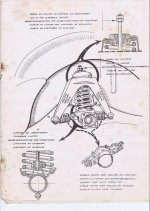This discussion split from thread linked below on 12/1/22 by admin as requested:
https://www.aussiefrogs.com/forum/index.php?threads/gordini-double-shaft-djet-engine.144933/
...........................................
I'm still a bit surprised though, as you are. There must be a good 1,000 4CVs in France I'd have thought. I reckon you'd sell several in Australia and we have perhaps a tenth of that number of cars.
https://www.aussiefrogs.com/forum/index.php?threads/gordini-double-shaft-djet-engine.144933/
...........................................
I've asked about this exactly in France. To replicate them properly you need some dimensions and spring specifications, a fair bit of work having been done by Gregoire to get them right, and that needs an example to measure up. They are very rare! I asked with a view to maybe getting a batch made professionally - I reckon you could sell them perhaps in the dozens (they won't be cheap). The answer I've had is that the the key component - the top spring housing piece - is a real practical problem being forged aluminium. I'd have thought you could do it in steel but it's out of my league. It would need a design exercise to do it safely.Perhaps it's an I.P. thing but I have always wondered why people don't craft their own Gregoire rear suspension kit.
I'm still a bit surprised though, as you are. There must be a good 1,000 4CVs in France I'd have thought. I reckon you'd sell several in Australia and we have perhaps a tenth of that number of cars.
Last edited by a moderator:


 in here. Back in the day of my 750s the rego man knew what to look for and went for the rear wheels first up ! Then suggested i do something about it before coming back ! A friend that was a Renault/Citroen mechanic told me to get some nylon bushes to replace the needle rollers, a known fix, and that would get it through the inspection OK which it did. But the nylon did hammer out so you put those silly radius arms on to help a bit. Even then I could see the geometry was wrong. That was the way it was in the 60s. Bump steer from the rear, as well as on/of power steer. Lucky they only had 29 HP. All my 750s had flogged out trunnions but I only bought cheap cars.
in here. Back in the day of my 750s the rego man knew what to look for and went for the rear wheels first up ! Then suggested i do something about it before coming back ! A friend that was a Renault/Citroen mechanic told me to get some nylon bushes to replace the needle rollers, a known fix, and that would get it through the inspection OK which it did. But the nylon did hammer out so you put those silly radius arms on to help a bit. Even then I could see the geometry was wrong. That was the way it was in the 60s. Bump steer from the rear, as well as on/of power steer. Lucky they only had 29 HP. All my 750s had flogged out trunnions but I only bought cheap cars.